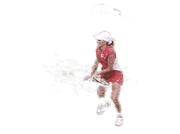Ball Speed in Pro Tennis
By John Yandell
It's indisputable that pro tennis has become a supersonic sport. But what do we REALLY know about the incredible speeds of the shots hit by the best players in pro tennis?
We know from the radar guns that pro serves routinely reach serve speeds of 120 to 130mph, and that players such as Andy Roddick and Taylor Dent are capable of hitting serves that reach speeds of 150mph--and more.
But what part of the serve does the radar gun reading represent? What happens to the speed of the serve over the course of its flight to the receiver? Is it going still 120mph at the time of the return?
What about the speed of the other shots besides the serve? How fast are players hitting forehands, backhands, volleys, overheads and returns? A common perception is that a great return can come back faster than the serve. How does this perception square with reality? The answers we found to all these questions may surprise you.
It happens too fast for the human eye to see. For this reason, it has gone completely unnoticed by experienced students of the pro game. But the results of our analysis showed that the ball actually slows down dramatically as it travels between the players. Virtually every shot in pro tennis loses at least 50% of its speed by the time it reaches the opponent. That's right, half--and usually even more. This was true on the serve. It was also true on the groundies, the returns, volleys, and overheads.
Let's look at how we did our study and the results on all the strokes. I think you'll find it as fascinating as we did. At the end, we'll also see some important implications for coaching and playing that can have a huge effect on your ability to time the ball, particularly on your opponent's biggest shots.
The Project
In 1997 and 1998 Advanced Tennis researchers, working in collaboration with Cislunar Aerospace in an educational program funded by NASA, set out to do the first ever study of ball speed in pro tennis. To do this, we filmed several matches played by the great Pete Sampras. We used two cameras set at right angles high above the court, one shooting across the net, and the other across the baseline.
Advanced Tennis principal scientist Nasif Iskander then digitized dozens of Pete's shots, capturing the trajectory of the ball in its flight between the players' rackets. Using an original piece of motion analysis software he created, Nasif was then able to measure the speed of the ball and how it changed over the course of the flight of each shot. (AdvancedTennis.com)
All told, Nasif analyzed over 50 Sampras hits by plotting over 4000 separate points in the flight of his and his opponent's shots. For the first time we had data on the speeds of the shot patterns of a world class player. This included the initial speed of the ball on every stroke and what happened to this initial speed both before and after the bounce, and at the time the opponent hit the next ball.
Results
Nasif found that the maximum speed recorded by the radar guns on the serve corresponded pretty closely with our digitized shot analysis. The average speed for the Sampras first serves in our digital analysis was 120mph. The average radar gun speed for the same serves was 117mph, a difference of less than 5%.
What spectators see on the radar guns is probably fairly accurate (although possibly less accurate on wide serves which travel at more of an angle to the radar gun beam.) But that's just the initial speed. What about the rest of the flight of the serve? What happened to it in the 3/4s of a second or less it took for Pete's serve to reach his opponent's racket?
The answer is that over the course of its flight, that 120mph serve actually slowed down to under 60 mph. It was going less than half its initial speed at the time of the return. This dramatic deceleration occurred in only a fraction of a second--3/4s of a second or less. So why and how does this happen?
There are two factors. The first is air resistance prior to the bounce. By the time the ball had bounced on the court, every Sampras shot--serve, groundstrokes, volleys--had lost roughly 25% of its initial speed due to the effect of the air on the ball, technically, the "drag".
The second factor is the friction of the bounce on the court. At the bounce, the ball lost another 25% of the initial speed, or slightly more, due to the friction between the bottom of the ball and the court surface. This is a radical change in speed that occurs in only 4 milliseconds or 1/250th of a second.
In total, Nasif analyzed 29 first serves. The analysis program showed that the average maximum speed of these serves was 120mph. Before the serve bounced in the service box, this average speed of these serves was down to 87mph due to the air resistance or drag on the ball as it traveled toward the receiver. After the bounce, the average speed serve was down to 62 mph. In the 4 milliseconds that the ball was in contact with the court, it lost 25mph.
Number of Serves |
MPH |
Pre-Bounce |
Post Bounce |
End |
29 |
120 MPH |
87 MPH |
62 MPH |
54 MPH |
Then, as the ball traveled toward the opponent after the bounce, it continued to lose even more speed. At the point the player hit the return--or the ball passed the baseline in the case of an ace--Pete's serve lost on average another 8mph. So that first serve may start off at 120mph, but it reaches the receiver at about 54mph. The following chart breaks it down so you can see the serves in both courts, both wide and down the middle.
Sampras 1st Serve:
Number of Serves |
Location |
Max MPH After Hit |
Pre-Bounce MPH |
Post Bounce MPH |
End MPH |
4 |
Deuce DTheM |
127 MPH |
89 MPH |
67 MPH |
58 MPH |
7 |
Deuce Wide |
113 MPH |
81 MPH |
57 MPH |
50 MPH |
13 |
Ad DTheM |
123 MPH |
90 MPH |
63 MPH |
55 MPH |
5 |
Ad Wide |
117 MPH |
86 MPH |
60 MPH |
53 MPH |
The Return of Serve
If the first serve in pro tennis is losing half its speed prior to the return, what about the speed of the return itself? Is it possible that the perception that the return can be "faster" than the serve actually true?
Nasif was able to measure the speed of 10 returns hit by Pete's opponents, as well as 3 returns hit by Sampras.
So is the return ever "faster" than the serve? Let's clarify the question. Is the initial velocity of the return faster than the initial velocity of the serve? Definitely no.
The initial velocity of the return is nowhere close to the initial velocity of the serve. The fastest return measured was a backhand hit by Sampras opponent Jonathan Stark that reached 70mph. The fastest return measured for Sampras was a forehand at 65mph. So the returns we recorded had an initial velocity equal to at most 60% of the initial velocity of a first serve. But put the question another way. Is the speed of the return faster than the speed of the serve just before it is hit? That answer is yes.
As outlined above, the analysis showed that by the time of the return, a 120mph first serve has slowed down by more than half, traveling at roughly 55mph. Our analysis also revealed that the initial velocity of many returns was higher than than that. On Pete Sampras's fastest return, for example, the speed of the serve had slowed 60mph at the time of the return. Sampras's return had an initial velocity of 65mph, about 10% higher than the speed of the ball at the time of the hit .
The fastest return we recorded, a backhand hit by Jonathan Stark, left Stark's racket at 70mph. This return was on a Sampras serve with an initial velocity of 125mph. that 125mph serve had slowed to 54mph just before Stark's hit. Stark's return added 16mph to the ball speed, increasingl the speed of the ball by about 30%. For the 3 Sampras returns studied, Sampras averaged 56mph, an increase of about 4mph over the speed of the incoming ball.
It should also be noted, however, that the average initial velocity of the return could also be less than the speed of the oncoming ball. For example, one Sampras backhand return left his racket at 49mph, 6mph slower than the incoming ball which was 55mph.
Based on the limited number of returns analyzed, it is difficult to conclude what the maximum potential speed of the return might be. Most all of Sampras's returns showed a slight increase in speed. One return by an opponent showed a 30% increase in speed. We can speculate that the most aggressive returners in the game could hit returns with even more velocity, approximating or exceeding the velocities of the groundstrokes as analyzed below.
Returns Over the Course of the Flight
After leaving the racket, the returns showed substantially loses in this initial velocity over the course of the flight. In fact the percentage of speed lost was slightly more on the returns than it was on the serves. Sampras' returns averaged an initial speed of 56mph, but slowed to an average of only 20mph at the end of their flight.
These 3 returns were typical of the returns of Pete's various opponents, which also lost well over a third of their speed before the bounce. The bounce of the ball on the court caused the shot to lose over a third of the remaining speed. After the bounce, the return continued to slow down, losing another 15-20%.
Sampras' Forehand Return:
Forehand Returns |
Pre-Hit Speed |
Max MPH After Hit |
Pre Bounce MPH |
Post Bounce MPH |
End MPH |
1 |
60 MPH |
65 MPH |
40 MPH |
30 MPH |
24 MPH |
Sampras' Backhand Return:
Number of Backhand Returns |
Pre-Hit Speed |
Max MPH After Hit |
Pre Bounce MPH |
Post Bounce MPH |
End MPH |
2 |
48 MPH |
51 MPH |
32 MPH |
21 MPH |
18 MPH |




